Realtime Body Sensors for Minimising Risk and Healthcare Costs
Info: 7566 words (30 pages) Example Research Project
Published: 1st Dec 2021
Tagged: Healthcare
1. A Secure GSM-Based Modern Healthcare System Using Body Sensor Network for Inmate
1.1 AIM & OBJECTIVE
Aim
The recommended model facilitate users to minimize health related risks and healthcare costs by fetching, recording, exploring and sharing data in real time and efficiently.
Health care requires contemporaneous pursuit of aims like:
- Enhancing the experience of health care
- Advancing the health of people
- Reducing the value of health monitoring devices
Objective
To design the modules which can monitor basic health conditions and give the message alert to the doctor wherein he can prescribe the medicine in the abnormal conditions and temporary medication is made available to the person. The specific goals to monitor health conditions are :
- A module to monitor the heartbeat based on counting the pulses
- A module to find out the temperature
- A module to analyze the breathing capacity of lungs and determine te healthy and unhealthy conditions
- A module to check out the ECG waveforms which is displayed on PC.
1.2 BLOCK DIAGRAM
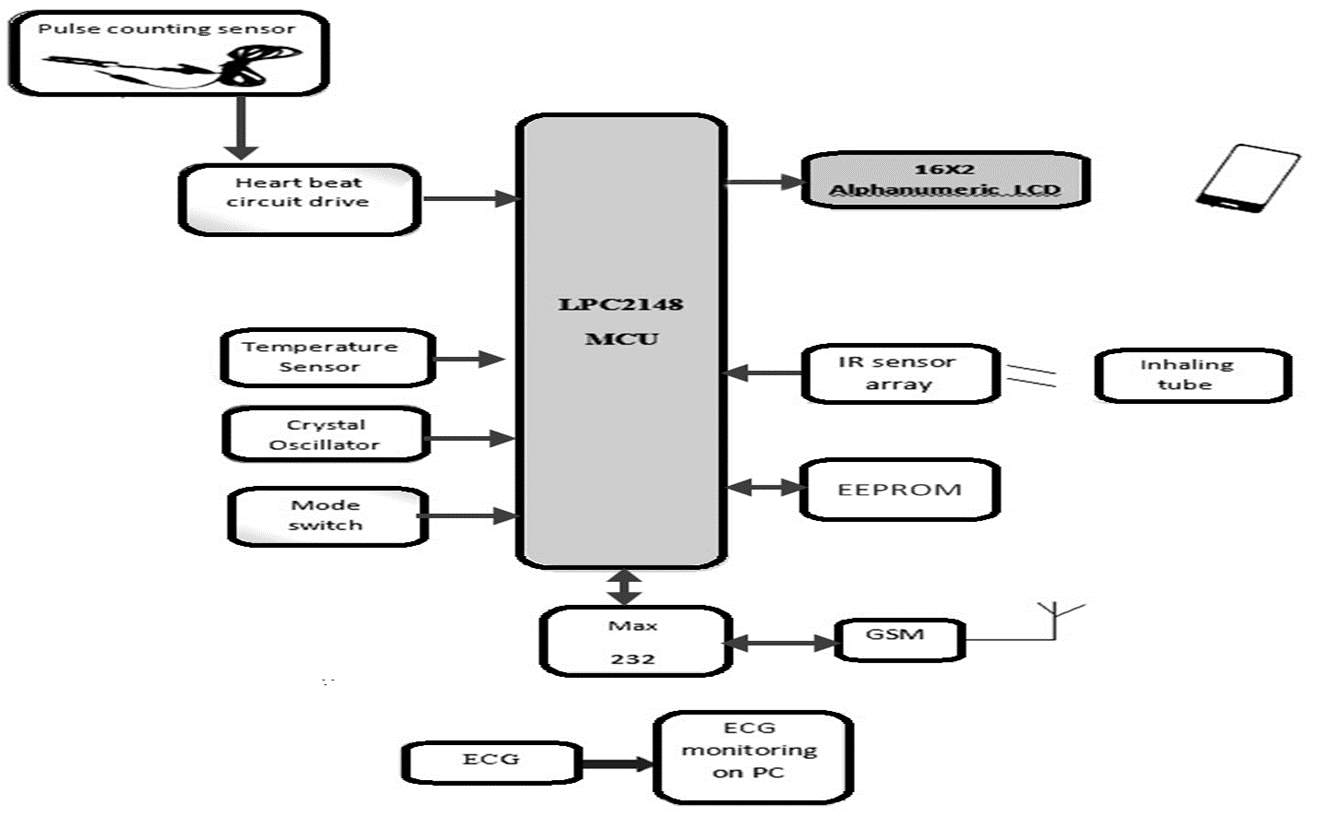
Fig.1.2 Block diagram of A Secure GSM-Based Modern Healthcare System Using Body Sensor Network for Inmate
1.3 SCHEMATIC DIAGRAM
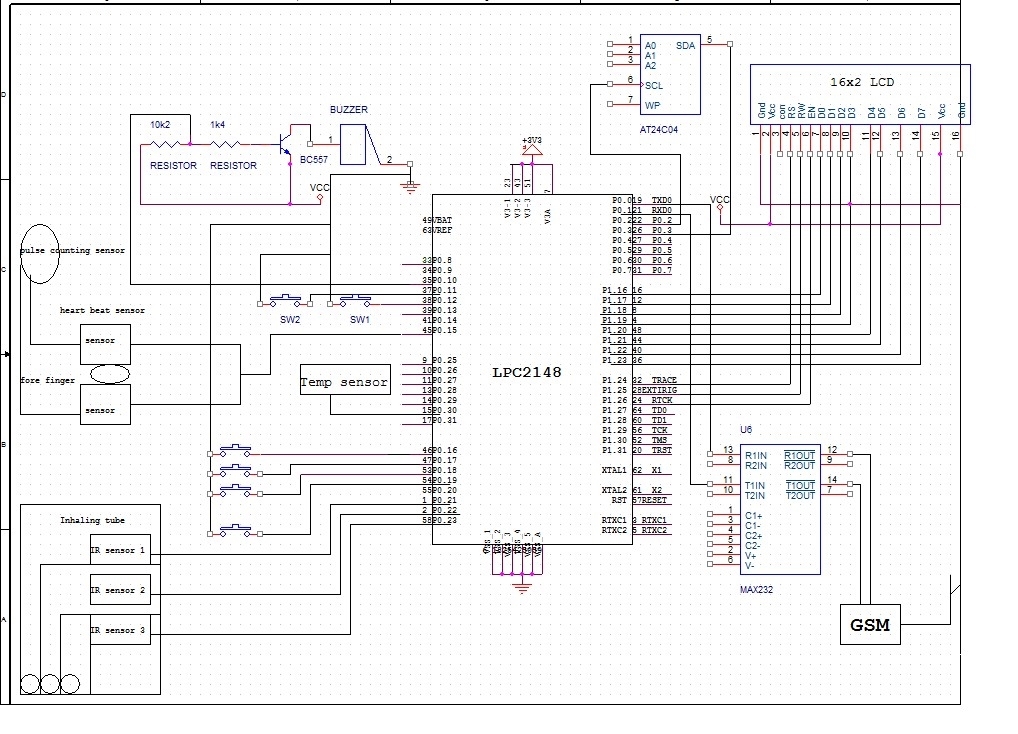
Fig 1.3 Schematic Diagram of A Secure GSM-Based Modern Healthcare System Using Body Sensor Network for Inmate
2. WORKING PRINCIPLE
This project uses LPC2148 microcontroller which acts as both input and output. Inputs to the microcontroller are the output results from heartbeat, temperature and lungs analysis. These outputs act as input to the microcontroller and the outputs of microcontroller are displayed on LCD.
The pulse sensor is connected to fingertip and uses the amount of infrared light reflected by the blood circulating inside to do just that. ..When the heart pumps, blood pressure rises sharply, and so does the amount of infrared light from the emitter that gets reflected back to the detectorand the value is displayed on the LCD. In case of abnormal condition immediately the message is sent to the corresponding doctor where he can reply back with the temporary medication to save the critical state of the person.
The other sensor is to know the temperature where in the temperature rise is manually done by giving external heat to the sensor so that it displays the abnormal condition and then the medicine is received to the person in the case when he is suffering
The way how lungs function is observed from the lungs health analyser where the persons inhales and holds the balls in the tubes. The cc range is given as per the age of a person where in there are switches to select ages of the person before he/she inhales and the case where it differs is displayed as unhealthy condition
The other parameter that is measured is about the heartbeat of the person through monitoring the graphical representation on the pc. The ECG is recorded and displayed on the pc. This is measured by placing the electrodes on the skin where there is connection between the blood that is flowing in the heart and the impulses that are carried by it.
3. HEALTH CARE HARDWARE MODULES DESCRIPTION
3.1 HEART BEAT MEASUREMENT
Heart rate is stated as the celerity of the heartbeat which is calculated on number of contractions of heart in a minute. The speed of the beat rate alters as per the body’s physical stress and emotional state. This module measures the heartbeat of an individual by using pulse counting sensor.
A type of optical pulse counting sensor is used to determine the heart rate based on the number of pulses detected by LED/IR pulse output. By counting these pulses and measuring the time between each pulse to the other pulse the heart beat value can be calculated. Most optical sensors which are used to find the heart rate consist of LED and an optical detector which illustrates the reflectance of the light from the skin. The reflectance is bit different during heartbeat and beat, thus the detector will observe a periodic signals in the duration of measurement from which heartbeat is extracted. The width of the pulse differs with respect to time from high pulse to low pulse. The time between the pulses gives the value of the beats. To detect these pulses there is a light sensor which exhibits the functioning of the sensor.
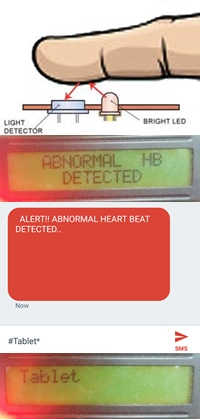
Fig. 3.1 Heartbeat measurement results
3.2 TEMPERATURE MEASUREMENT
Temperature Sensor is a two terminal IC transducer that gives an output current proportional to absolute temperature. The sensor package is small with a low thermal mass and a fast response time. The most common temperature range is 55 to 150°C (-58 to 302°F).
FEATURES DESCRIPTION
- Calibrated Directly in ° Celsius (Centigrade)
- Linear + 10 mV/°C Scale Factor • 0.5°C Ensured Accuracy (at +25°C) • Rated for Full −55°C to +150°C Range
- Suitable for Remote Applications
- Low Cost Due to Wafer-Level Trimming
- Operates from 4 to 30 V
- Less than 60-μA Current Drain
- Low Self-Heating, 0.08°C in Still Air
- Nonlinearity Only ±¼°C Typical
- Low Impedance Output, 0.1 Ω for 1 mA Load

Fig. 3.2 Temperature module results
3.3 LUNGS ANALYZER MODULE
These analysis is based on the inhaling power of the person. The infrared rays act as medium between the rise of the level and the inhaling capacity which holds the balls in the tube to indicate the level

Fig. 3.3 Lungs Health Analyser result
The healthy level and unhealthy conditions are sent in the form of message to the doctor immediately after the output displayed on LCD.
4. COMPONENTS DESCRIPTION
4.1 POWER SUPPLY
A device or gadget that substances electrical or different varieties of power to an output load or group of hundreds is called an electricitysupply unit or PSU. The time period is maximum generally implemented to electrical strength resources, much less frequently to mechanical ones, and infrequently to others.
The term “strength deliver” is once in a while limited to those devices that convert a few other form of strength into electricity (together with sun strength and fuel cells and generators). An extra correct term for gadgets that convert one form of electric electricity into some other shape (together with transformers and linear regulators) is energy converter. The most common conversion is from AC to DC.
AQ regulated energy supply or stabilized energy supply is one that includes circuitry t Ao tightly manage the output voltage and/or modern to a specific price. The unique price is closely maintained no matter versions within the load presented to the strength deliver’s output, or any reasonable voltage variation on the energy supply’s input.

Fig. 4.1.1 Block diagram of power supply
Rectifier:
The output from the transformer is fed to the rectifier. It converts A.C. into pulsating D.C. The rectifier may be a half wave or a complete wave rectifier. In this assignment, a bridge rectifier is used because it deserves to be a desirable balance amplifier in a circuit, which converts an ac voltage to dc voltage use of each half of cycles of the enter ac voltage. The Bridge rectifier circuit has four diodes linked to shape a bridge. The ac enter voltage is applied to the diagonally opposite ends of the bridge. The burden resistance is connected among the other ends of the bridge.
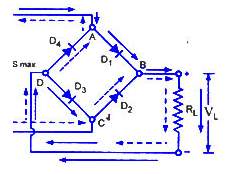
Fig. 4.1.2 Bridge Rectifier
For the wonderful 1/2 cycle of the enter ac voltage, diodes D1 and D3 conduct, while diodes. D2 and D4 continue to be in the OFF country. The conducting diodes will be in collection with the burden resistance RL and hence the weight present day flows via RL. For the bad half of cycle of the enter ac voltage, diodes D2 and D4 behaviour while, D1 and D3 stay OFF. The undertaking diodes D2 and D4 could be in collection with the burden resistance RL and therefore the present day flows via RL within the equal path as inside the preceding half cycle. Consequently a bi-directional wave is converted right into a unidirectional wave.
Capacitive filter:
Capacitive filter out is used in this challenge. It removes the ripples from the output of rectifier and smoothens the D.C. Output received from this filter out is regular until the mains voltage and load is maintained regular. However, if either of the 2 is numerous, D.C. voltage acquired at this factor modifications. Consequently a regulator is carried out on the output stage.
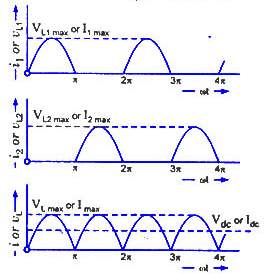
Fig. 4.1.3 Rectified Output waveforms
Capacitive filter is used in this mission. It removes the ripples from the output of rectifier and will smoothens the D.C. Output obtained from this clear out is regular until the mains voltage and cargo is maintained consistent. However, if either of the 2 is various, D.C. voltage obtained at this point adjustments. Consequently a regulator is implemented on the output level.
Regulator:
The micro controller and other devices get strength supply from AC to DC adapter via voltage regulator. The adapter output voltage will be 12V DC non-regulated. The 7805/7812 voltage regulators are used to transform 12V to 5VDC.
As the call itself implies, it regulates the entered power to carry out. A voltage regulator is an electrical regulator designed to mechanically maintain a consistent voltage level. On this task, electricity supply of 5V and 12V are required. So as to obtain these voltage ranges, 7805 and 7812 voltage regulators are to be used. The primary range 78 represents high quality supply and the numbers 05, 12 constitute the specified output voltage tiers.
4.2 ARM LPC2148 MICROCONTROLLER
The LPC2148 is a 64 pin microcontroller out of which forty six/forty eight pins are based on a 16-bit/32-bit ARM7TDMI-CPU with real-time emulation and embedded trace aid, that integrate microcontroller with embedded excessive pace flash memory ranging from 32 kB to 512 kB. A 128-bit wide memory interface and particular accelerator architecture allow 32-bit code execution on the maximum clock price. For essential code length programs, the opportunity 16-bit Thumb mode reduces code with the aid of more than 30 % with minimal performance penalty. Because of their tiny length and low power consumption, they are best for the applications where miniaturization is a key requirement, consisting of get right of entry to manage and point-of-sale.
Serial communications interfaces ranging from a USB 2.zero complete-pace tool, multiple UARTs, SPI, SSP to I2C-bus and on-chip SRAM of eight kB up to forty kB, make these devices thoroughly suitable for verbal exchange gateways and protocol converters, smooth modems, voice reputation and coffee give up imaging, presenting each big buffer length and high processing power. various 32-bit timers, individual or twin 10-bit ADC(s), 10-bit DAC, PWM channels and forty five speedy GPIO strains with as much as 9 side or level touchy outside interrupt pins make these microcontrollers appropriate for business manipulate and scientific systems.
Key features
- 16-bit/32-bit ARM7TDMI-S microcontroller in a tiny LQFP64 package.
- 8 kB to 40 kB of on-chip static RAM and 32 kB to 512 kB of on-chip flash memory.
- 128-bit wide interface/accelerator enables high-speed 60 MHz operation.
- In-System Programming/In-Application Programming (ISP/IAP) via on-chip boot loader
- Software. Single flash sector or full chip erase in 400 ms and programming of
- 256 bytes in 1 ms.
- EmbeddedICE RT and Embedded Trace interfaces offer real-time debugging with the
- On-chip RealMonitor software and high-speed tracing of instruction execution.
- USB 2.0 Full-speed compliant device controller with 2 kB of endpoint RAM.
- In addition, the LPC2146/48 provides 8 kB of on-chip RAM accessible to USB by DMA.
- One or two (LPC2141/42 vs. LPC2144/46/48) 10-bit ADCs provide a total of 6/14
- analog inputs, with conversion times as low as 2.44 μs per channel.
- Single 10-bit DAC provides variable analog output (LPC2142/44/46/48 only).
- Two 32-bit timers/external event counters (with four capture and four compare
- Channels each), PWM unit (six outputs) and watchdog.
- Low power Real-Time Clock (RTC) with independent power and 32 kHz clock input
- Multiple serial interfaces including two UARTs (16C550), two Fast I2C-bus (400 kbit/s),
- SPI and SSP with buffering and variable data length capabilities.
- Vectored Interrupt Controller (VIC) with configurable priorities and vector addresses.
- Up to 45 of 5 V tolerant fast general purpose I/O pins in a tiny LQFP64 package.
- Up to 21 external interrupt pins available.
- 60 MHz maximum CPU clock available from programmable on-chip PLL with settling
- Time of 100 μs.
- On-chip integrated oscillator operates with an external crystal from 1 MHz to 25 MHz.
- Power saving modes include Idle and Power-down.
- Individual enable/disable of peripheral functions as well as peripheral clock scaling for
- Additional power optimization.
- Processor wake-up from Power-down mode via external interrupt or BOD.
- Single power supply chip with POR and BOD circuits:
- CPU operating voltage range of 3.0 V to 3.6 V (3.3 V ± 10 %) with 5 V tolerant I/V
4.2.1 Pin diagram and Description

Fig. 4.2.1 Pin diagram of LPC2148
Port pin description
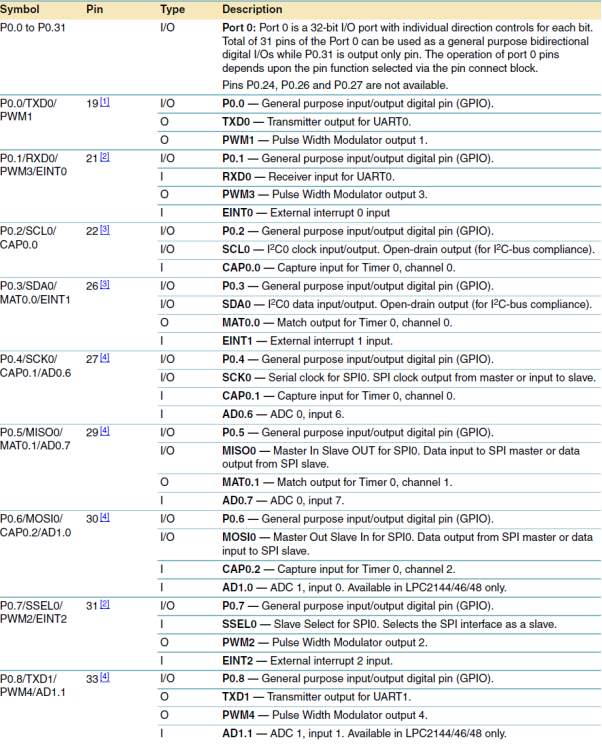
Table. 4.2.1.Port0 pin description
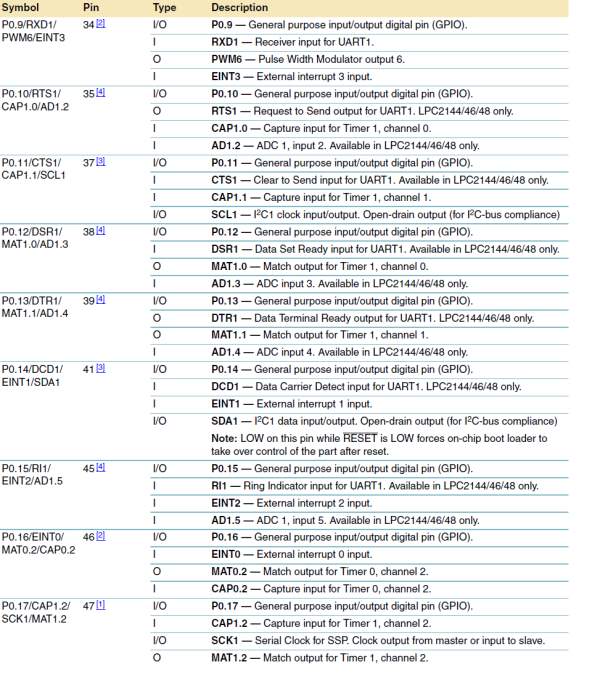
Table. 4.2.2 Port0 pin description
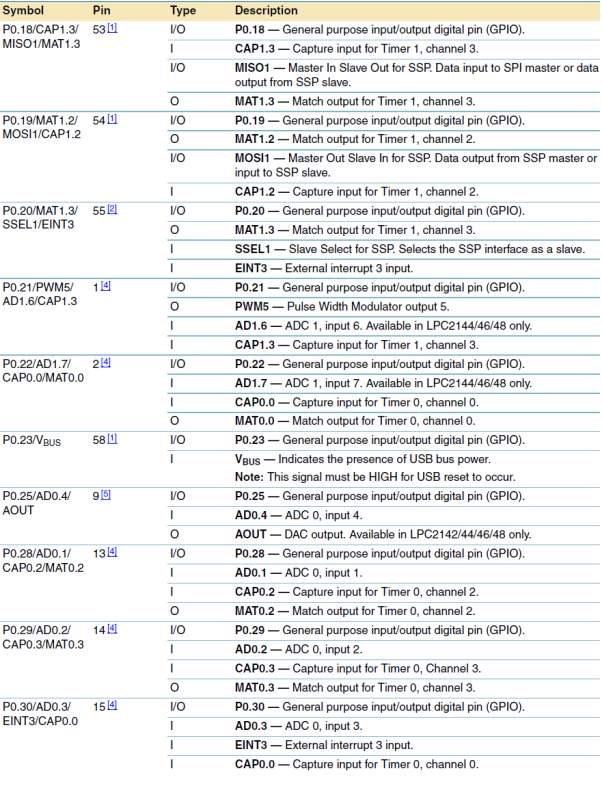
Table. 4.2.3 Port0 Pin Description

Table. 4.2.4 Port1 Pin Description
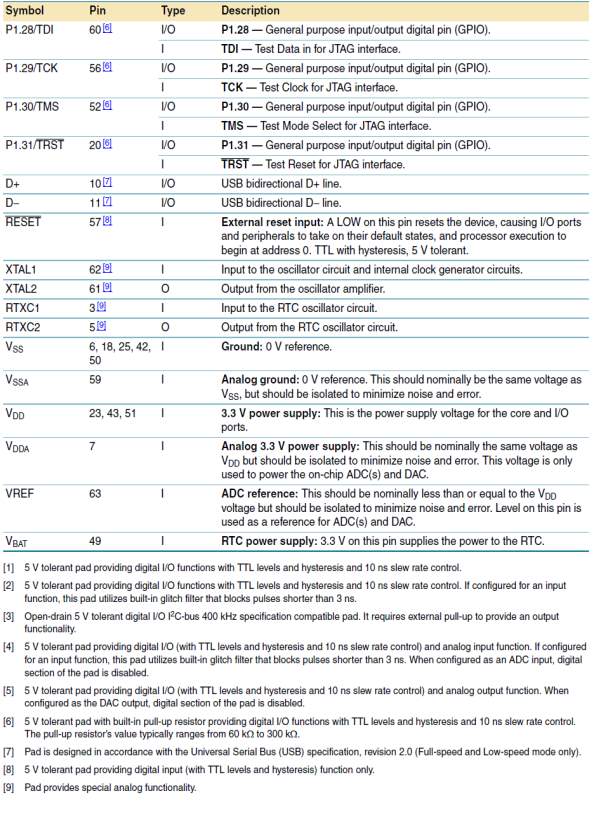
Table. 4.2.5 Port1 Pin description
4.2.2 Functional Description
On-chip flash program reminiscence:
The LPC2148 includes a 32kB,64kB, 128kB,256kB and 512kB flash reminiscence device respectively. This reminiscence can be used for both code and facts garage. Programming of the flash memory may be executed in several approaches. It can be programmed in machine through serial port. The application software may erase and/or program the flash at the same time as the application is going for walks, permitting a top notch degree of flexibility for information storage subject firmware improvements, etc., Due to architectural solution selected for an on-chip boot loader, flash reminiscene to be had for consumers code on LPC2148 flash memory affords at least 100,000 erase/write cycles and twenty years of statistics retention.
On-chip static RAM:
On-chip static RAM may be used for code and/or information garage. The SRAM may be accessed as 8-bit, sixteen-bit, and 32-bit. LPC2148 provide eight kB, sixteen kB and 32 kB of static RAM respectively. In case of LPC2146/48 simplest, an 8 kB SRAM block meant to be applied especially by way of the USB can also be used as a fashionable reason RAM for facts storage and code storage and execution.
Interrupt Controller:
The Vectored Interrupt Controller (VIC) accepts all the interrupt request inputs and categorizes them as fast Interrupt Request (FIQ), vectored Interrupt Request (IRQ), and non-vectored IRQ as defined by means of programmable settings. The programmable mission scheme method that priorities of interrupts from the numerous peripherals can be dynamically assigned and adjusted. rapid interrupt request (FIQ) has the best priority. If a couple of request is assigned to FIQ, the VIC combines the requests to provide the FIQ sign to the ARM processor. The fastest possible FIQ latency is completed when most effective one request is classified as FIQ, due to the fact then the FIQ service ordinary does now not want to branch into the interrupt carrier ordinary however can run from the interrupt vector area.
If more than one request is assigned to the FIQ magnificence, the FIQ service ordinary will examine a phrase from the VIC that identifies which FIQ source(s) is (are) asking for an interrupt. Vectored IRQs have the middle precedence. sixteen of the interrupt requests can be assigned to this category. Any of the interrupt requests may be assigned to any of the 16 vectored IRQ slots, among which slot zero has the best precedence and slot 15 has the bottom. Non-vectored IRQs have the bottom priority. The VIC combines the requests from all the vectored and non-vectored IRQs to supply the IRQ sign to the ARM processor.
The IRQ carrier ordinary can start with the aid of reading a check in from the VIC and leaping there. If any of the vectored IRQs are pending, the VIC gives the address of the very best-precedence asking for IRQs service ordinary, in any other case it gives the deal with of a default routine that is shared by means of all the non-vectored IRQs. The default recurring can read every other VIC sign in to peer what IRQs are energetic.
Interrupt assets:
Each peripheral tool has one interrupt line linked to the Vectored Interrupt Controller, but might also have numerous inner interrupt flags. Personal interrupt flags might also represent a couple of interrupt supports.
Pin connect block:
The pin connect block lets in selected pins of the microcontroller to have multiple characteristic. Configuration registers manage the multiplexers to permit connection between the pin and the on chip peripherals. Peripherals ought to be related to the perfect pins previous to being activated, and previous to any related interrupt(s) being enabled. Pastime of any enabled peripheral characteristic that isn’t mapped to a associated pin have to be considered undefined. The Pin manipulate Module with its pin select registers defines the functionality of the microcontroller in a given hardware environment. After reset all pins of Port 0 and 1 are configured as input with the subsequent exceptions: If debug is enabled, the JTAG pins will count on their JTAG capability; if hint is enabled, the hint pins will assume their trace capability. The pins related to the I2C0 and I2C1 interface are open drain.
Speedy general cause parallel I/O (GPIO):
Tool pins that aren’t connected to a particular peripheral function are controlled with the aid of the GPIO registers. Pins may be dynamically configured as inputs or outputs. Separate registers permit placing or clearing any number of outputs concurrently. The cost of the output sign up may be read again, as well as the modern-day kingdom of the port pins. LPC2148 introduce multiplied GPIO functions over previous LPC2000 gadgets:
- GPIO registers are relocated to the ARM neighbourhood bus for the fastest viable I/O timing.
- Masks registers permit treating sets of port bits as a group, leaving other bits unchanged.
- All GPIO registers are byte addressable.
- Entire port value can be written in one practise.
- Bit-stage set and clean registers allow instruction set or clean of any variety offbits in a single port.
- Direction manipulate of individual bits.
- Separate manage of output set and clear.
- All I/O default to inputs after reset.
10 Bit ADC:
The LPC21418 comprise one analog to virtual converters. Those converters are 10-bit successive approximation analog to virtual converters. At the same time as ADC0 has six channels, ADC1 has eight channels. Consequently, general variety of available ADC inputs for LPC2148 is 14. The LPC2148 contain two analog to virtual converters. Those converters are single 10-bit successive approximation analog to digital converters. While ADC0 has six channels, ADC1 has eight channels. Consequently, overall variety of to be had ADC inputs for LPC21418 is 14.
Capabilities:
- 10 bit successive approximation analog to virtual converter.
- Measurement range of zero V to VREF (2.zero V = VREF = VDDA).
- Each analog enter has a committed result sign in to lessen interrupt overhead.
- Burst conversion mode for single or more than one inputs.
- Non-compulsory conversion on transition on input pin or timer suit sign.
10 bit DAC
The DAC enables the LPC2148 generate a variable analog output. The maximum DAC output voltage is the VREF voltage.
Functions:
- 10-bit DAC.
- Buffered output.
- Strength-down mode available.
- Selectable pace as opposed to strength.
USB 2.zero tool controller:
The USB is a 4-cord serial bus that supports communique between a host and a number of (127 max) of peripherals. The host controller allocates the USB bandwidth to attached devices via a token based totally protocol. The bus supports warm plugging, unplugging, and dynamic configuration of the gadgets. All transactions are initiated by the host controller. The LPC2148 is prepared with a USB tool controller that enables 12 Mbit/s information exchange with a USB host controller. It consists of a sign up interface, serial interface engine, endpoint buffer memory and DMA controller.
The serial interface engine decodes the USB data stream and writes statistics to the best give up factor buffer reminiscence. The status of a finished USB switch or blunders situation is indicated thru status registers. An interrupt is likewise generated if enabled. A DMA controller (to be had in LPC2146/48 only) can switch facts between an endpoint buffer and the USB RAM.
UART:
The LPC2148eight each comprise two UARTs. In addition to standard transmit and obtain statistics traces, the LPC2148 UART1 also gives a full modem control handshake interface. in comparison to previous LPC2000 microcontrollers, UARTs in LPC2148 introduce a fractional baud charge generator for each UARTs, allowing these microcontrollers to attain general baudrates such as 115200 with any crystal frequency above 2MHz. similarly, automobile-CTS/RTS flow-manipulate capabilities are absolutely carried out in hardware.
Features:
- 16 byte acquire and Transmit FIFOs.
- Register locations agree to „550 enterprise general.
- Receiver FIFO trigger points at 1, four, eight, and 14 bytes
- Integrated fractional baud charge generator masking wide range of baud costs with out a want for external crystals of particular values.
- Transmission FIFO manage enables implementation of software (XON/XOFF) float control on each UARTs.
I2C-bus serial I/O controller:
LPC2148 contains I2C-bus controllers. The I2C-bus is bidirectional, for inter-IC manage the usage of most effective two wires: a serial clock line (SCL), and a serial facts line (SDA). every tool is recognized by a unique deal with and can operate as either a receiver-only device (e.g., an lcd driver or a transmitter with the functionality to both receive and ship facts (inclusive of memory)). Transmitters and/or receiver scan perform in both master or slave mode, depending on whether or not the chip has to initiate a records switch or is best addressed. The I2C-bus is a multi-master bus, it could be controlled by means of a couple of bus grasp connected to it. The I2C-bus carried out in LPC2141/forty two/44/forty six/48 helps bit fees up to 400 kbit/s (speedy I2C-bus).
Functions:
- Compliant with trendy I2C-bus interface.
- Clean to configure as grasp, slave, or master/slave.
- Programmable clocks permit versatile rate control.
- Bidirectional information transfer between master and slaves.
- Multi-master bus (no central grasp).
- Arbitration between concurrently transmitting masters without corruption of serial facts on the bus.
- Serial clock synchronization allows gadgets with distinctive bit charges to talk via one serial bus.
- Serial clock synchronization may beused as a handshake mechanism to droop and resume serial switch.
SPI serial I/O controller:
The LPC2148 comprise one SPI controller. The SPI is a full duplex serial interface, designed to address more than one masters and slaves related to a given bus. Simplest a single master and a single slave can communicate on the interface in the course of a given records switch. Throughout an information switch the grasp always sends a byte of statistics to the slave, and the slave continually sends a byte of records to the grasp.
Features
- Compliant with Serial Peripheral Interface (SPI) specification
- Synchronous, Serial, complete Duplex, conversation.
- Mixed SPI master and slave.
- Most statistics bit price of one eigth of the input clock free.
Crystal oscillator
On-chip integrated oscillator operates with outside crystal in range of one MHz to twenty-five MHz. The oscillator output frequency is called fosc and the ARM processor clock frequency is referred to as CCLK for functions of charge equations, and so on. fosc and CCLK are the equal cost except the PLL is going for walks and related. check with phase 6.19.2 “PLL” for extra records.
PLL
The PLL accepts an enter clock frequency in the range of 10 MHz to twenty-five MHz. The input frequency is extended up into the variety of 10 MHz to 60 MHz with a modern managed Oscillator (CCO). The multiplier may be an integer fee from 1 to 32 (in exercise, the multiplier cost can’t be higher than 6 on this family of microcontrollers due to the upper frequency restriction of the CPU). The CCO operates within the range of 156 MHz to 320 MHz, so there is an additional divider within the loop to keep the CCO within its frequency range even as the PLL is presenting the preferred output frequency. The output divider may be set to divide with the aid of 2, four, eight, or sixteen to produce the output clock. for the reason that minimal output divider value is two, it’s miles insured that the PLL output has a 50 % obligation cycle. The PLL is turned off and bypassed following a chip reset and may be enabled through software. this system must configure and set off the PLL, anticipate the PLL to fasten, then connect with the PLL as a clock supply. The PLL settling time is 100 µs.
Reset and wakeup timer:
Reset has sources at the LPC2141/forty two/forty four/46/forty eight: the RESET pin and watchdog reset. The RESET pin is a Schmitt trigger enter pin with a further glitch filter out. assertion of chip reset through any source begins the Wake-up Timer (see Wake-up Timer description underneath), causing the inner chip reset to remain asserted till the external reset is de-asserted, the oscillator is walking, a set quantity of clocks have surpassed, and the on-chip flash controller has finished its initialization. While the inner reset is eliminated, the processor starts executing at cope with 0 that is the reset vector. At that point, all of the processor and peripheral registers have been initialized to predetermined values. The Wake-up Timer guarantees that the oscillator and other analog features required for chip operation are absolutely practical before the processor is allowed to execute instructions. This is important at energy on, all varieties of reset, and every time any of the aforementioned features are turned off for any cause. for the reason that oscillator and other capabilities are turned off throughout energy-down mode, any wake-up of the processor from strength-down mode uses the Wake-up Timer. The Wake-up Timer video display units the crystal oscillator because the means of checking whether or not it’s far secure to begin code execution. When strength is applied to the chip, or a few occasion caused the chip to exit power-down mode, while is needed for the oscillator to supply a sign of enough amplitude to force the clock logic. the amount of time relies upon on many elements, such as the price of VDD ramp (in the case of strength on), the kind of crystal and its electrical characteristics (if a quartz crystal is used), as well as any other outside circuitry (e.g. capacitors), and the characteristics of the oscillator itself beneath the prevailing ambient conditions.
External interrupt inputs:
LPC2148 includes up to 9 facet or stage sensitive external Interrupt Inputs as selectable pin capabilities. When the pins are combined, outside occasions may be processed as 4 independent interrupt signals. The outside Interrupt Inputs can optionally be used to wake-up the processor from electricity-down mode. Moreover capture input pins also can be used as outside interrupts without the option to wake the tool up from strength-down mode.
RS232 CABLE:
To permit compatibility amongst statistics communication gadget, an interfacing preferred known as RS232 is used. considering the standard was set long before the appearance of the TTL logic family, its enter and output voltage tiers are not TTL compatible. for that reason, to attach any RS232 to a microcontroller system, voltage converters together with MAX232 are used to convert the TTL logic degrees to the RS232 voltage stages and vice versa.
4.3 EEPROM
EEPROM is a memory storing device which is used widely because of its features. The data can be erased electrically as the name notates electrically erasable memory device. The memory storage capacity of this tiny device is 4kb and it is re used based on the requirement
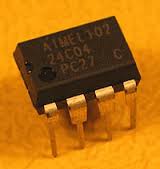
Fig. 4.3 EEPROM
The data stored by this EEPROM is the registered number and the receiving mobile number which includes the information of the medicines prescribed by the doctor and the message sent to the doctor in the detection of abnormal conditions.
4.4 MAX232
Max232 IC is a specialized circuit which makes standard voltages as required with the aid of RS232 standards. This IC affords first-class noise rejection and really reliable against discharges and brief circuits. MAX232 IC chips are typically referred to as line drivers.
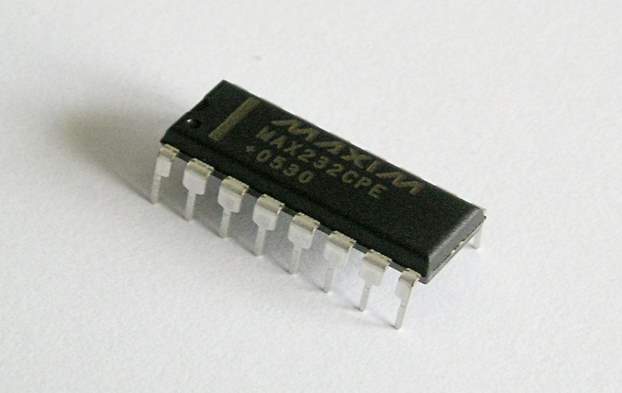
Fig. 4.4 MAX232 IC
 To make sure facts switch between pc and microcontroller, the baud rate and voltage degrees of Microcontroller and computer have to be the equal. The voltage degrees of microcontroller are logic1 and common sense 0 i.e., common sense 1 is +5V and good judgment zero is 0V. But for laptop, RS232 voltage ranges are considered and they’re: good judgment 1 is taken as -3V to -25V and logic 0 as +3V to +25V. So, so one can identical these voltage degrees, MAX232 IC is used. As a consequence this IC converts RS232 voltage stagesto microcontroller voltage levels and vice versa.
To make sure facts switch between pc and microcontroller, the baud rate and voltage degrees of Microcontroller and computer have to be the equal. The voltage degrees of microcontroller are logic1 and common sense 0 i.e., common sense 1 is +5V and good judgment zero is 0V. But for laptop, RS232 voltage ranges are considered and they’re: good judgment 1 is taken as -3V to -25V and logic 0 as +3V to +25V. So, so one can identical these voltage degrees, MAX232 IC is used. As a consequence this IC converts RS232 voltage stagesto microcontroller voltage levels and vice versa.
4.5 SWITCHES
A switch array is used to select the age of the person. Depending on the age of the person the value is given and if the output value is different. Initially the switch is selected so that the microcontroller reads the value and displays the output in normal and abnormal conditions.

Fig. 4.5 Switch array
4.6 LCD
LCD is the combination of two states which is solid and liquid state and is used to display a visible image of characters.
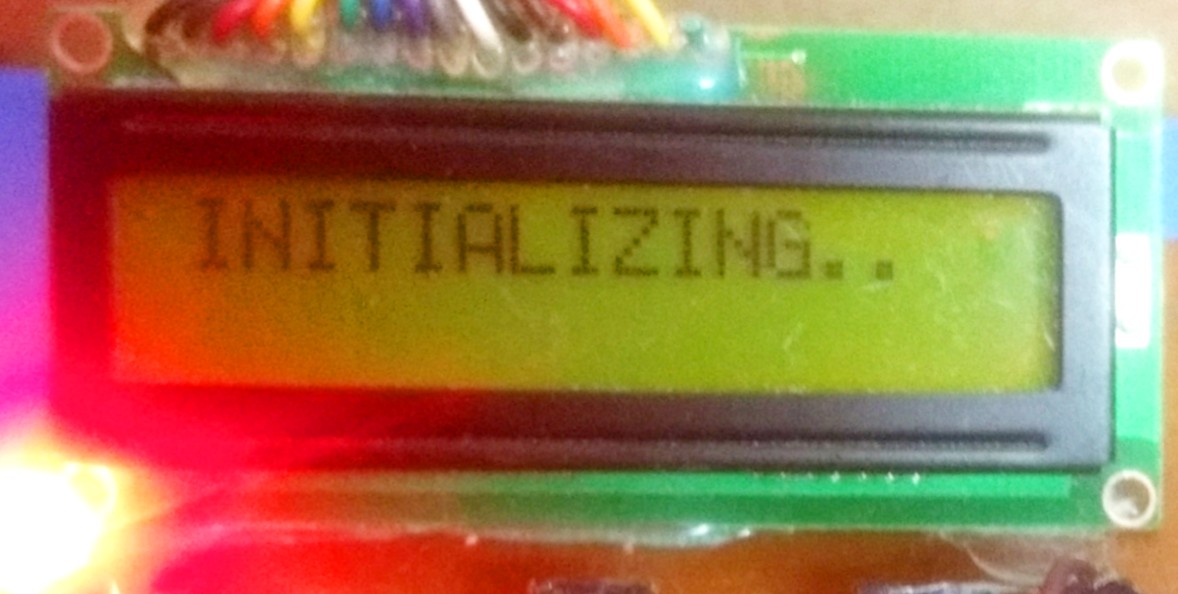
Fig. 4.6 LCD display
This indicates that the LCD is ready to display the output if the health condition and the message sent from the doctor is also displaye don LCD. This type of LCD displays 16×2 characters.
5. ECG MODULE
5.1 ECG WORKING
A record which displays a graphical waveformsof a person heart beat is represented in the form of ECG. Heart is unique magic muscle which is an intrinsic conduction system where the ability if creating impulses is carried out by its own without any type of influence from outside.
When these electrical impulses are occurring in heart it creates a current which is spread to the body and they reach skin. The complete number of impulses are calculated and graphed in the form of ECG.
An ECG test is performed by placing electrodes on the skin where they are interacted with the electrical impulses in the body. AS these electrical impulses pass from artria to ventricles then there is variation between electrodes and the performance of heart function is obtained.
In an ECG there are three distinct waves which indicate the heart functioning. These three waves named as P wave, QRS wave, T wave together represent the functioning of heart beat.
- P wave: Contraction of artria
- QRS wave : Depolarization of ventricles
- T wave : Repolarization of ventricles
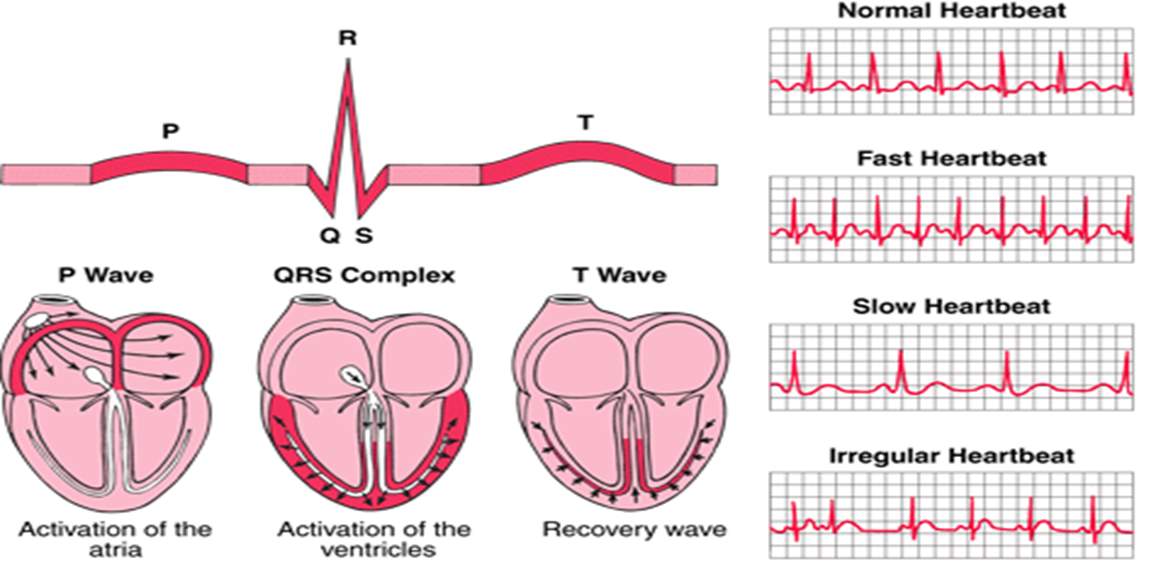
Fig. 5.1.1 ECG Representation
The variation in these waves describes the heart heath condition of the person. The different conditions of heart is observed from the distance between these waves and the condition if the person is analysed. With a view to be capable of report myocardial activity, the electrocardiograph desires if you want to stumble on tiny modifications in capacity at the frame surface. We are talking about signals which can be frequently around 1mV, and may be smaller. Similarly, we need a few reference point to which we relate the capability modifications.
This is measured by connecting the electrodes to the body. The 12-lead ECG is used to find the heartbeat, over time there are several systems developed that make up to 12-lead ECG. They are:
Bipolar leads: the reference factor is on one limb, the `sensing’ electrode (if you desire) is on some other limb. The leads are termed I, II, and III.

Fig. 5.1.2 Bipolar leads placement
Unipolar leads: The reference point is several leads joined collectively, and the sensing lead is on one limb. Those leads are conventionally augmented, in that the reference lead on the limb being sensed is disconnected from the opposite two.

Fig. 5.1.3 Unipolar leads placement 1

Fig. 5.1.4 Unipolar leads placement 2
The V leads, which expand throughout the precordium, V1 within the fourth right interspace, V2 4th left, V4 on the apex (5th interspace, midclavicular line), V3 midway in between V2 and V4, and V5 & V6 in the fifth interspace on the anterior and mid axillary traces respectively.

Fig. 5.1.5 V leads placement
We can visualise the directions of the various leads — I factors left, and aVF points immediately down (in a ‘Southward’ route). The alternative leads are organized around the points of the compass — AVL approximately 30o more north of I, II down toward the left foot, about 60o south of I, and III off to the right of AVF. AVR `looks’ on the coronary heart from up and right, so efficiently it is seeing the chambers of the heart, and maximum deflections in that lead are poor (internet high-quality vector in AVR is uncommon, and suggests that lead placement was incorrect. If the leads had been successfully sited, then assume dextrocardia or some different unusual congenital abnormality).
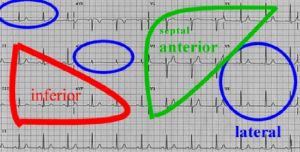
Fig. 5.1.6 Visulization of LED’s
It is normal to organization the leads in step with which part of the left ventricle (LV) they examine. AVL and that i, in addition to V5 and V6 are lateral, while II, III and AVF are inferior. V1 thru V4 have a tendency to observe the anterior factor of the LV (a few check with V1 and V2 `septal’, however a higher call is perhaps the `proper oriented leads’). changes in depolarisation within the posterior aspect of the coronary heart aren’t directly visible in any of the conventional leads, even though “replicate photo” adjustments will tend to be picked up in V1 and V2.
ECG paper is traditionally divided into 1mm squares. Vertically, ten blocks generally correspond to at least one mV, and on the horizontal axis, the paper pace is usually 25mm/s, so one block is 0.04s (or 40ms). notice that we also have “huge blocks” which might be 5mm on their aspect.

Fig. 5.1.7 Paper presentation
Always check the calibration voltage on the right of the ECG, and paper velocity. the following picture suggests the everyday 1mV calibration spike.
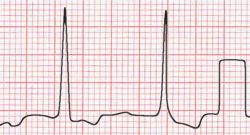
Fig.5.1.8 ECG graphical presentation
5.2 ECG CONDITIONS
1. Sinus bradycardia
Aside from healthy, however in any other case everyday people, there may be a protracted list of conditions where sinus bradycardia happens, along with:
- hypothermia;
- expanded vagal tone (due to vagal simulation or e.g.pills)
- hypothyroidism;
- beta blockade;
- marked intracranial high blood pressure
- obstructive jaundice and even in uraemia
- structural SA node disorder, or ischaemia
2. Sinus Tachycardia
Continually remember pain as a likely purpose of tachycardia.
- Any cause of adrenergic simulation(including ache)
- Thyrotoxicosis;
- Hypovolaemia;
- Vagolytic capsules (e.g. atropine)
- Anaemia, being pregnant;
- Vasodilator tablets, together with many hypotensive agents;
- Fever
If the rate is almost exactly 150, always make sure that you are not mistaking atrial flutter with a 2:1 block for sinus tachycardia.
Rhythm
Sinus arrhythmia and heart price variability
There’s commonly a mild diploma of chaotic variant in heart rate, known as sinus arrhythmia. Sinus arrhythmia is usually a good element, and lack of this chaotic variant is of ominous prognostic significance. Submit myocardial infarction, a metronome-like regularity of the pulse is associated with an accelerated likelihood of unexpected demise, and simply before the onset of ventricular tachycardia (or fibrillation), variability is lost! Absence of any sinus arrhythmia indicates an autonomic neuropathy.

Fig. 5.2.1 Sinus arrhythmia representation
Atrial extrasystoles
These rise up from ectopic atrial foci. Commonly, the ectopic beat always arises at about the identical time after the sinus beat.

Fig .5.2.2 Atrial extra systoles representation
The ectopic beat commonly discharges the SA node, so subsequent beats of SA foundation aren’t in synchrony with the previous sinus rhythm.
If the extrasystole takes place early on, it may discover the His-Purkinje gadget no longer quite prepared to get hold of an impulse, and a diploma of block can be visible. That is termed `aberration’. Distinguish between an atrial extrasystole, and an atrial break out beat, wherein the SA node falters, and a subsidiary pacemaker takes over.
Supraventricular tachyarrhythmias (SVT)
Irregular SVT
 By way of far the most typical purpose of irregular SVT is atrial traumatic inflammation, in which the atrial price is inside the location of 450 to 600/min, and the atria honestly do now not contract rhythmically in any respect. The atrium “fibrillates”, writhing like a bag of worms. The conventional view of the pathogenesis of AF is that there are multiple re-entrant `wavelets’ shifting thru the atrial muscle, however recent proof suggests that plenty AF honestly arises from ectopic interest inside the muscular cuff surrounding the pulmonary veins where they enter the left atrium. AF is concept to beget further AF thru “electrical remodelling” — electrophysiological changes that are induced in atrial myocytes due to fast rates and the consequent calcium loading.
By way of far the most typical purpose of irregular SVT is atrial traumatic inflammation, in which the atrial price is inside the location of 450 to 600/min, and the atria honestly do now not contract rhythmically in any respect. The atrium “fibrillates”, writhing like a bag of worms. The conventional view of the pathogenesis of AF is that there are multiple re-entrant `wavelets’ shifting thru the atrial muscle, however recent proof suggests that plenty AF honestly arises from ectopic interest inside the muscular cuff surrounding the pulmonary veins where they enter the left atrium. AF is concept to beget further AF thru “electrical remodelling” — electrophysiological changes that are induced in atrial myocytes due to fast rates and the consequent calcium loading.

Fig. 5.2.3 Irregular SVT
Note that in the above tracing of AF, the ventricular response rate seems rather slow, so we suspect that AV block has been increased using pharmacological manipulation. In uncontrolled AF, rates of about 130 or more are common.
Other causes of irregular SVT are:
- Frequent atrial extrasystoles;
- Multifocal atrial tachycardia, where there are three or more distinct atrial foci, combined with tachycardia. There is often severe underlying disease (e.g. chronic obstructive airways disease), and in the ICU setting, MAT has a poor prognosis.
- “Atrial flutter with variable block”.

Fig . 5.2.4 Irregular SVT in other case
Although it looks like atrial fibrillation, the above image actually shows multifocal atrial tachycardia. Note how there are at least three different P wave configurations!
Regular SVT
A trial flutter is common. The atrial rate is commonly 300/min, and there is usually a 2:1 block, resulting in a ventricular response rate of 150/min. Other ratios are possible, and sometimes the ratio varies. This rhythm is often unstable, and the heart may flip in and out of sinus rhythm, or there may be runs of atrial fibrillation.
Cite This Work
To export a reference to this article please select a referencing stye below:
Related Services
View allRelated Content
All TagsContent relating to: "Healthcare"
Healthcare is defined as providing medical services in order to maintain or improve health through preventing, diagnosing, or treating diseases, illnesses or injuries.
Related Articles
DMCA / Removal Request
If you are the original writer of this research project and no longer wish to have your work published on the UKDiss.com website then please:




